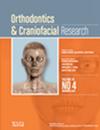Three-dimensional assessment on digital cast of spontaneous upper first molar distorotation after Ni-ti leaf springs expander and rapid maxillary expander: A two-centre randomized controlled trial
Abstract
Objective
The aim of this randomized controlled trial (RCT) was to evaluate the spontaneous distorotation of upper first permanent molars and the transverse dentoalveolar changes on digital casts in growing patients following maxillary expansion treatment using either the Leaf Expander® or the rapid maxillary expander (RME), both anchored to the deciduous second molar.
Trial Design and Setting
This study was a two-arm, parallel-assignment, RCT with a dual-centre design conducted at two teaching hospitals in Italy.
Participants
Inclusion criteria included maxillary transverse deficiency, prepubertal development stage (cervical vertebra maturation stage [CVMS] 1–2) and early mixed dentition with fully erupted upper first permanent molars. Exclusion criteria were systemic diseases or syndromes, CVMS 3–6, agenesis of upper second premolars, unavailability of the second deciduous molar for anchorage and Class III malocclusion.
Randomization
Patients were randomly assigned to the Leaf Expander® or RME group using a computer-generated randomization list created by a central randomization centre. Randomization was conducted immediately before the start of treatment.
Intervention
The intervention involved treatment with either the Leaf Expander® or the RME. Both devices were anchored to the second deciduous molars. Following randomization, patients were further categorized based on the presence of no crossbite, unilateral crossbite or bilateral crossbite.
Main Outcome Measure
The primary outcome measure was the distorotation of the upper first molar (U6). Secondary outcomes included measurements of interdental linear dimensions, specifically upper inter-canine width (53–63), upper inter-molar width (MV16–MV26) and upper inter-deciduous second molar width (55–65).
Blinding
The examiner analysing the digital casts was blinded to the treatment groups to prevent detection bias and ensure objective assessment. However, due to the nature of the intervention, blinding was not feasible for the patients and clinicians involved in administering the treatment.
Results
A total of 150 patients were enrolled and randomly assigned to two groups: 75 to the Leaf Expander® group and 75 to the RME group. Recruitment started in November 2021 and was completed in November 2022. At the time of analysis, the trial was complete with no ongoing follow-ups. ANOVA tests revealed no significant differences between the three subgroups (no-cross, unilateral-cross and bilateral-cross) within both the Leaf Expander® and RME groups at T0. The Leaf Expander® demonstrated significantly greater distorotation in the unilateral crossbite subgroup compared to the RME (p = .014). In terms of total molar distorotation, the Leaf Expander® appliance showed a significantly greater effect (12.66°) compared with conventional RME (7.83°). Linear regression analysis demonstrated a significant correlation between the extent of expansion and the degree of molar rotation.
Conclusions
Maxillary expansion resulted in significant spontaneous molar distorotation when the appliance was bonded to the second deciduous molars. The Leaf Expander® exhibited significantly greater molar distorotation compared with conventional RME. The degree of molar distorotation was correlated with the extent of expansion obtained on the second deciduous molar.
Trial Registration
The trial was registered at ClinicalTrials.gov (ID: NCT05135962).


 求助内容:
求助内容: 应助结果提醒方式:
应助结果提醒方式:


